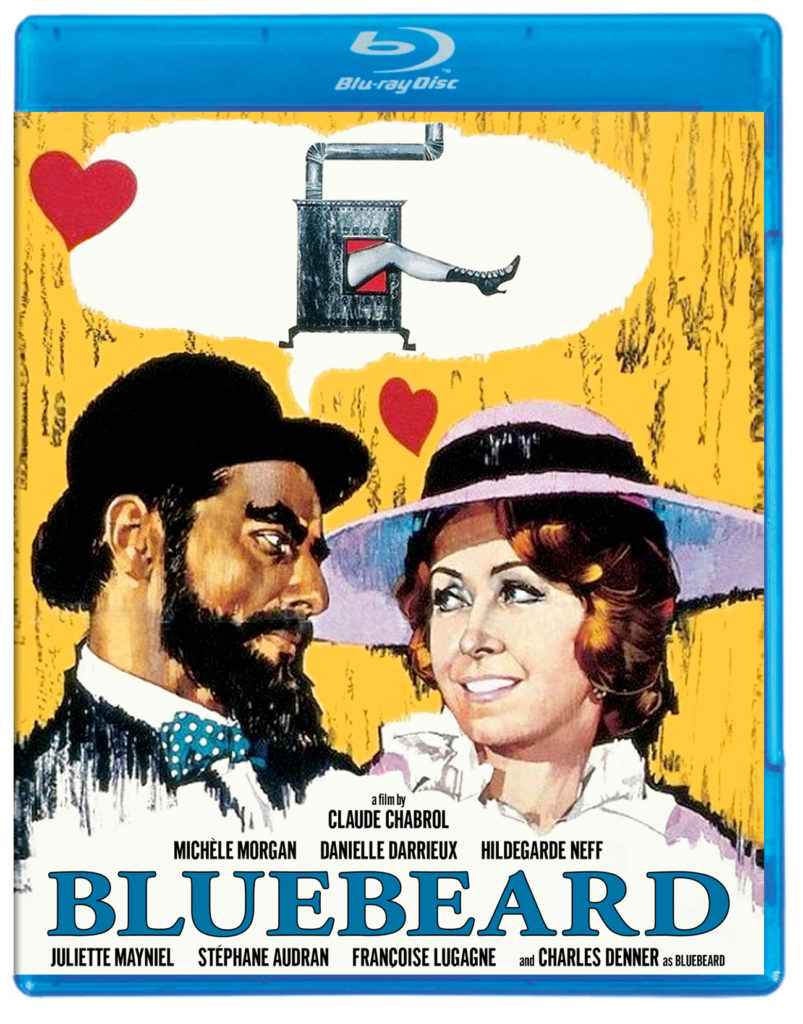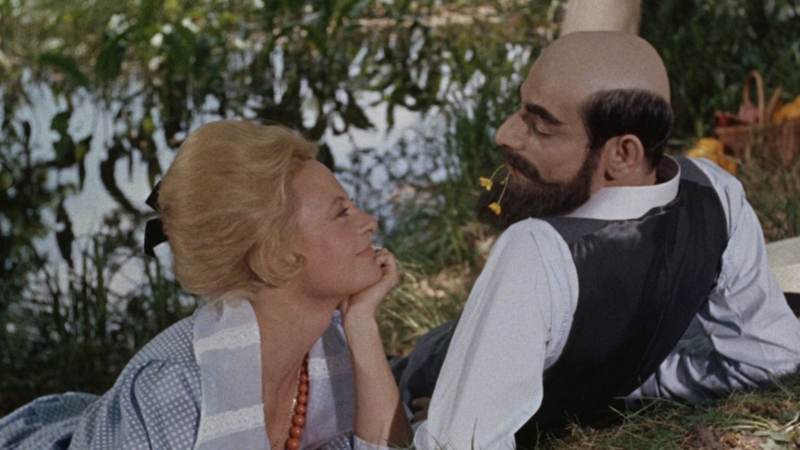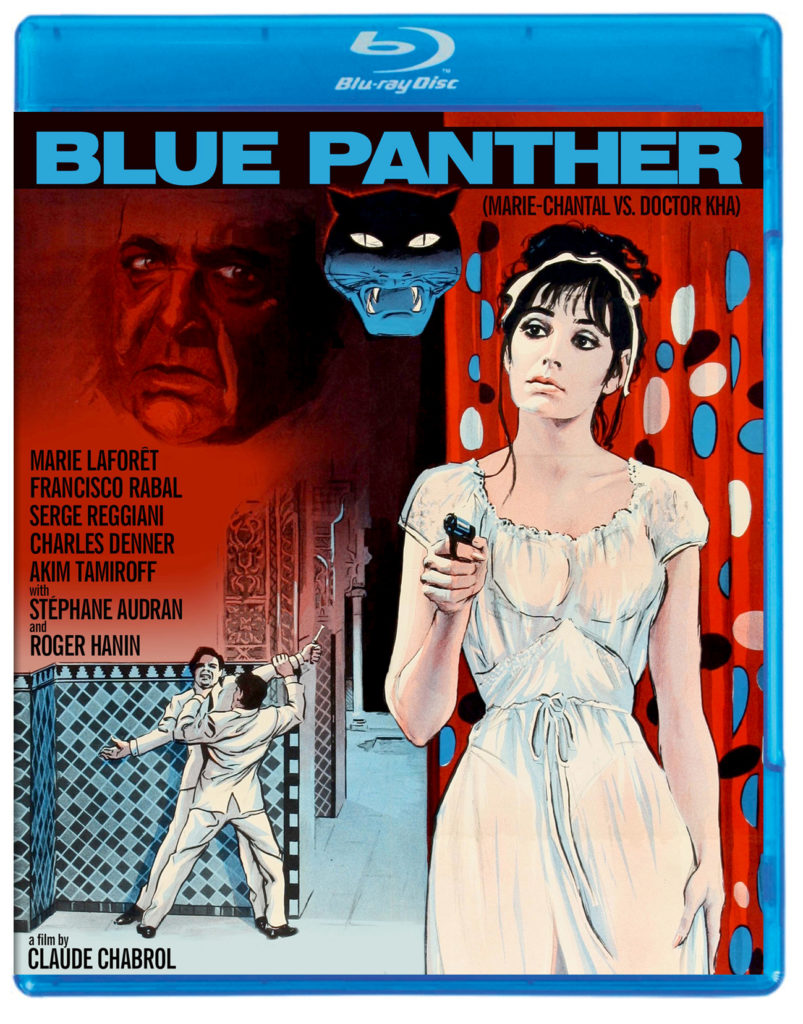Two From French No(n)-Waver Claude Chabrol’s “Wilderness Era”, New On Blu-ray.
STREET DATE: September 14th, 2021/KINO LORBER STUDIO CLASSICS
French New Wave dissenter Claude Chabrol subverts story, genre, and audience expectations in a pair of films from his mid-1960’s commercial period – otherwise called the director’s “wilderness era” – presented in 4K restoration Blu-rays, after lengthy unavailability on home video, by Kino Lorber Studio Classics.
As a founding member of the French New Wave, an early writer for the polemic film journal Cahiers du Cinema, and the first among a group of French filmmakers, including François Truffaut, Jean-Luc Godard, Eric Rohmer, and Jacques Rivette, to complete a feature-length film – 1958’s Le Beau Serge – Claude Chabrol was also among the first New Wave filmmakers to artistically turn his back on the express tenets of the movement he helped start – after a string of commercial flops following his second New Wave feature, 1959’s Les Cousins – in order to warily embrace the mainstream. He was subsequently dismissed in the pages of the very film journals whose reputation he had helped establish as a “commercial hack”.
Chabrol characteristically countered by calling the “New Wave” a “marketing ploy”, never a coherent “movement”, and subversively settled into a highly successful, five-decade, sixty-credit film career; mainly working in the loosely-defined – especially given the breadth, depth, and variety of his filmography – but still incredibly profitable crime-thriller genre. And although he again apparently left the still narrowly-defined “arthouse” behind after his initial New Wave features, everything Chabrol directed thereafter, even as a director-for-hire, inescapably carried his unmistakable directorial stamp.
Which, again, loosely stated and nebulously defined, would seem to have entirely upheld the artistic impetus of the French New Wave in the first place. Nevertheless, it might be a good moment here to mention a famous quote frequently brought up in a Chabrolian context specifically regarding – and categorically dismissive of – the very concept of a “French New Wave”. So, not speaking French, and having seen it translated in a few different wordings, I’ll have to loosely paraphrase that, regarding his own films, and in terms of Chabrol’s unique artistic expression and methodology, “there is no wave, only the sea” when it comes to his films as a body of work. And it is ‘at sea’ that many new viewers to this vast and deceptively non-wavy sea-body of work — any isolated moment of deceptive tranquility sure to conceal treacherous depths and sinking turmoil — may possibly find their most intriguing port of entry.
Sink or swim, two films from Chabrol’s “wilderness era” – where my nautical metaphors are swallowed up in a wordy whirlpool (or “word-pool”, thank-you-very-much), but also where Chabrol the popular filmmaker began, in the early-to-mid 1960’s, to define his filmmaking style both within and against the mainstream (maritime pun recovered on the latter part of that compound) – invites this nascent audience, myself included, to either drown in or sail through the artistic obstacle-bouys, led cautiously by the stylistic searchlights, towards the far-from-safe shore. Viewer-navigating these choppy cinematic waters, KL offers irresistible passage aboard two of the most challenging and confounding vessels to ever sail the good sea Chabrol.
BLUEBEARD
DIRECTED BY CLAUDE CHABROL/1963

Based on the infamous World War I-era serial killings of (mainly) widowed women by bourgeois husband, entrepreneur, and con man Henri Désiré Landru, a case which also inspired Charlie Chaplin’s controversial 1947 black farce Monsieur Verdoux, Chabrol and screenwriter and novelist Françoise Sagan (Bonjour Tristesse) upset any expectation viewers might have for any post-Psycho (1960) depiction of a serial murderer with 119 minutes of cold, calculated murder.
In which murder, or even violence, is never explicitly shown, but instead suggested by découpage, décor, mise en scène, and other discreetly French terms that just now escape my recall. As brilliantly played by poised, compact Charles Denner, bald-capped and pointy-bearded to present a frighteningly sedate screen double for the historical Landru, Chabrol’s murderous maniac appears almost anything but. Rather, our intrepid killer traipses nonchalantly through — and practically unnoticed in — nondescript parks, boulevards, banks, and sitting rooms; a Parisian paterfamilias who just happens to murderously victimize vulnerable women.
Screen legends Michèle Morgan, Danielle Darrieux, and Hildegarde Neff appear over the title, Juliette Mayniel, Stéphane Audran, Françoise Lugagne appearing under — Catherine Rovel, Denise Provence, and Mary Marquet rounding out the list of actresses playing Landru’s varying victims (some not literally murdered, but all victims of his crimes in the end) — with the title role credited last of this modern Bluebeard, whose original French title was actually Landru. Screen-filing past in numbingly repetitious scenes of a vacant-eyed pick-up on a park bench, followed by non-romantic interludes at the opera, a rumbling train ride to the country, and building past a scene of curiously passionless seduction to a jarring freeze frame and a black plume of smoke wafting to the atmosphere thereafter — the elderly English couple next door complaining exasperatingly about the smell — these are impassive murders for profit made by a man seemingly without qualities.
How did the historical Landru escape detection for so long? Foremost in Denner’s portrayal, Sagan’s dialogue, and Chabrol’s direction, the distanced and distancing nature of these murders are (non-explicitly) emphasized: showing the historical context of both provincial and urban France being emptied of vital-aged males due to the first World War; the attitudes and psychosocial complexities of the larger cultural milieu, where questionable and even abusive male behavior went unseen or was simply ignored; and finally the effortlessly deceptive blank slate of a born conniver, strolling arm-in-arm with his next victim past a public-at-large who, at worst, may have dimly perceived a gossip-worthy “ladies’ man”.

The final question of how Landru’s many victims were so easily duped is perhaps the most chilling of all, with Chabrol’s non-leading style in particular being the most frustrating yet ultimately intriguing aspect. By offering the audience no explanation, in essence denying the viewer any port of entry to the “real” personality or motivations of the fictional or historical Landru, to say nothing of his unfortunate victims, the ancient Bluebeard legend simply perpetuates itself past his gallows’ hanging with an equally non-definitive THUD!
As Landru states himself: in the end, he “takes his baggage” with him.
BLUE PANTHER
DIRECTED BY CLAUDE CHABROL/1965

If Alfred Hitchcock was Chabrol’s touchstone for Bluebeard, with his sly visual flourishes and drily detached visual compositions providing cinematic parallels to the master of suspense, Blue Panther, a swinging sixties spy spoof made for Italian film mogul Carlo Ponti, shows the influence of Chabrol’s other great cinematic forefather, Fritz Lang. But just as Chabrol actively denies that artistic debt in the former with a frustratingly open-ended style and structure, Chabrol’s similarly disturbing, countering approach to sinister mayhem, shrouded conspiracy, and pulse-pounding pursuit is equally perverse for presenting the latter as a colorful, light-hearted romp.
Marie-Chantal (Marie Laforêt) in all respects of the word plays a carefree society girl who meets cute with a handsome secret agent (Roger Hanin) aboard a train vacation-bound to Switzerland. Introduced in the previous scene stabbing a sleeping, snoring rival through the heart with a stretched-out clothes-hanger, Agent Alias, or whatever his name might be, has acquired the title object and for reasons best left unexamined entrusts this priceless jewel of international pursuit to our apparently irresponsible, madcap heiress. Looks can be deceiving, however, no more so than in this film, and Marie-Chantal is soon eluding, outwitting, seducing, fighting, and beating a dangerous ring of spies — mischievously played by the likes of Charles Denner, Serge Reggiani, and Stéphane Audran — working at various levels of eccentricity (and not to mention comprehensibility) for the mysterious Dr. Kha (Akim Tamiroff).
Originally titled Marie-Chantal Vs. Dr. Kha, the switch to the objet de MacGuffin — whose ruby eyes turn out to contain either the secret to or the deadly virus itself set to wipe out all humanity (!) — may further indicate the twice-removed sensation of warily enjoying a movie expressly designed, seemingly, for a viewer to make neither head nor tails of. The inscrutable rivalry of the Vs. giving way to a pin-broach avatar of an animal not existing in nature — possibly going a Pink Panther (1963) one better? — may be in keeping with an irresistible pop art milieu taking us from a snow-bound Swiss ski-resort to a sweltering Moroccan open-marketplace; but where Blue Panther separates from the spy-skewering, near-contemporary likes of Modesty Blaise (1966), In Like Flint (1967), The Wrecking Crew (1968), and the original Casino Royale (1967) is the actual and realistic level of danger that Chabrol introduces and interweaves throughout the irreducible irresponsibility.
The aforementioned heart-stabbing that opens the film blithely building in subsequent sequences to (director-cameo!) poisoning, arrow-shooting, height-toppling, throat-slitting, railing-choking, and, in the Moroccan marketplace scene, a jarring camera-thrust to the public disemboweling of a sheep, even the relatively innocent Marie-Chantal, as charmingly portrayed by French pop star Marie Laforêt, is soon judo-throwing and choke-holding — the equally charming Stéphane Audran, no less — with the best. (Or worst, depending on one’s point of view.)

What’s it all about? Even after two viewings, the second with the aid of truly expert commentary (but more on that in a bit), this viewer couldn’t entirely say; but possibly the best compliment I personally could pay this film is that, for its vividly realistic tone of unreality, The Blue Panther almost exactly replicated the sensation of watching a Bond movie as a way-too-young kid and not knowing what the hell was going on.
But still loving it. For all its gruesome goofiness, oddball characters, and plot (purposely) bordering on incomprehensibility — who are these people? whose side are they on? are there sides? — Blue Panther alias Marie-Chantal Vs. Dr. Kha brought back for me the vaguely guilty yet undeniably enjoyable viewing experience of finding all these spy shenanigans so simultaneously pleasurable and distasteful.
Which leads me to wonder, per Chabrol’s overall artistic intention, if this is in fact always the right response?
…
In any event, it seems appropriate to end that part of our review with an open-ended question. And while these are separate Blu-ray releases, many other curious Chabrol devotees may also view these two wildly diverging, genre-defying commercial entries from Claude Chabrol together and similarly find Bluebeard and Blue Panther, re-title-linked in translation past their narrow domestic releases of nearly sixty years ago, more alike in skewed sensibility and directorial expression than different in artistically superficial details like plot or setting. Drab WWI-era Paris and its environs is united with bright, jet-setting mid-century locales by much more than simply their (re-)titled color, and aiding immeasurably once more in one’s respective pursuit(s) of, if not understanding, then brilliant illumination, KL has again assembled the right commentators for their always (in)valuable commentary tracks.
Kat Ellinger on Bluebeard makes a strong case for Chabrol’s countering approach to his misogynistic killer, teasing out the ambiguities and inconsistencies of the historical Landru in his confounding and cynical film portrayal forty years later. Drawing viewers’ attention to coal chutes, parasols and bizarrely suggestive table ornaments, Ellinger links the minute details of film analysis to larger, thematic discussions — if not, again, simplistic explanations — of an ultimately unknowable killer that, in no small way, seemed to sum up his era by the very qualities he (profoundly) lacked.
Next, the three-voiced commentary-hydra of Howard S. Berger, Steve Mitchell, and Nathaniel Thompson work their wonders on the equally challenging Blue Panther, with again Berger the theorizer, Mitchell the explicator, and Thompson the contextualizer waging valiant interpretive battle on the many confounding levels of Claude Chabrol’s meta-spy spoof-cum-proto-psychedelic-reality-bender. Introducing topics as equally and wildly diverse, yet also equally and bizarrely relevant, as Green Acres, Dr. Mabuse, and the Bond films of Guy Hamiliton — with a prolonged discussion of the first ten minutes of Peter Hunt’s On Her Majesty’s Secret Service (1969) its perception-altering centerpiece — Berger, Mitchell, and Thompson make a fun yet disquieting film seem even moreso, and Chabrol’s gleeful wreckage of even-then well-worn spy tropes appear all the more remarkable.
And finally, just a word of thanks to all those commentators listed above for not only making my job of writing this review a little easier, but for also providing a great introduction to these previously unknown-to-me Chabrol off-classics. One hopes Kino Lorber has more such restoration-releases in store, as the sometimes overlooked and daunting Chabrol filmography still contains many yet-unearthed treasures. Looking as beautifully mid-1960’s as one could hope for on high-definition home video, the pastel-dominant, restrained visual palette of the former exploding into the bold-colored pop art compositions of the latter — displaying the full range of Claude Chabrol’s frequent cinematographer Jean Rabier between them — these “wilderness era” entries from Chabrol’s Blue period are certainly ripe for rediscovery.
As Blue as the fathomless sea, perhaps, but as one can attest to in the equally vast Chabrol expanse — even after some 2,000 or so insufficient words — as un-tranquil for its deceptive lack of waves.
Images used in this review are credited to DVDBeaver and Mubi.

